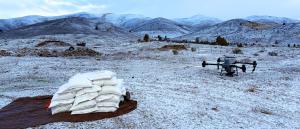
In the heart of Wasco County, a remarkable partnership between the Oregon Department of Fish and Wildlife (ODFW) and local ranchers is transforming the aftermath of devastating wildfires into an inspiring story of resilience, collaboration, and innovation. Together, they are spearheading a cutting-edge drone-based reseeding effort aimed at restoring critical habitats and enhancing the landscape for wildlife and agriculture alike.
The Tygh Ridge Mule Deer Migration Corridor Emergency Seeding Project, funded by a $241,914 Access and Habitat grant, brings together advanced drone technology, multispectral imaging, and the unwavering support of the local ranching community. After wildfires scorched over 32,000 acres during the summer of 2024, ODFW identified approximately 2,100 acres across private ranch lands as priorities for restoration.
Drones: The Future of Precision Restoration
This effort marks a significant shift from traditional seeding methods. Using drones equipped with multispectral imaging, the team, piloted by Columbia Gorge Community College (CGCC) instructor and Tygh Valley rancher Mike Davis, can identify areas most in need of reseeding, including severely burned soil and north-facing slopes with optimal soil conditions. Drones are also deployed to deliver the seeds, providing precision placement while minimizing disruption to the fragile post-fire landscape.
Hilary Doulos, Conservation Liaison at ODFW, emphasized the importance of this approach: "Multispectral imaging ensures that every seed has the best chance to take root by targeting areas with the highest potential for germination success. It’s a game-changer for post-fire restoration."
Ranchers Leading the Way
The collaboration with local ranchers has been exceptional, with landowners contributing in-kind resources such as ATVs, tractors, drones, and labor. Ranchers are demonstrating their commitment to long-term ecological health. Rancher and CGCC instructor Davis praised the partnership: "We’re not just rebuilding what was lost; we’re making it better. This is about protecting our livelihoods and creating a sustainable future for wildlife and agriculture."
Benefits Beyond Reseeding
The project goes beyond ecological restoration. By enhancing critical winter habitats for mule deer and other species, it ensures that these lands remain viable for wildlife while supporting the region’s ranching economy. The reseeding efforts also reduce the risk of invasive annual grasses taking over, which could fuel future wildfires. Additionally, the diverse seed mixes, which include native grasses, flowering herbs (forbs), and legumes, are designed to support pollinators and improve forage for species such as elk, turkeys, and upland birds.
This groundbreaking project also underscores the vital role of education in advancing drone technology for real-world applications. CGCC’s Uncrewed Aircraft Systems (UAS) classes equip students with the skills to operate drones for diverse industries, including agriculture, environmental conservation, and emergency response. By training future drone pilots and data analysts, CGCC is fostering innovation and preparing students for high-demand careers in this rapidly growing field. Mike Davis highlights the synergy between education and practical application: “Projects like this demonstrate how drone technology can address critical challenges while inspiring students to explore its potential. It’s incredibly rewarding to see our work in the classroom translate into meaningful impact on the ground.”
Students enrolled in CGCC’s UAS courses are prepared to become Certified Drone Pilots (FAA Part 107) and can learn technologies such as aerial photogrammetry and precision mapping—tools integral to efforts like the Tygh Ridge restoration.
A Model for the Future
As wildfires become more frequent and severe, the Tygh Ridge project offers a scalable model for other regions grappling with post-fire restoration. By blending innovative technology with grassroots collaboration, it showcases how communities can come together to heal the land and strengthen resilience against future challenges.
The success of this project is a testament to the power of partnership, technology, and a shared commitment to the land. As the first seeds take root this spring, the legacy of this extraordinary effort will grow, much like the ecosystem it seeks to restore.
For now, the skies above Tygh Valley are not just filled with the buzz of drones—they hum with hope and progress.